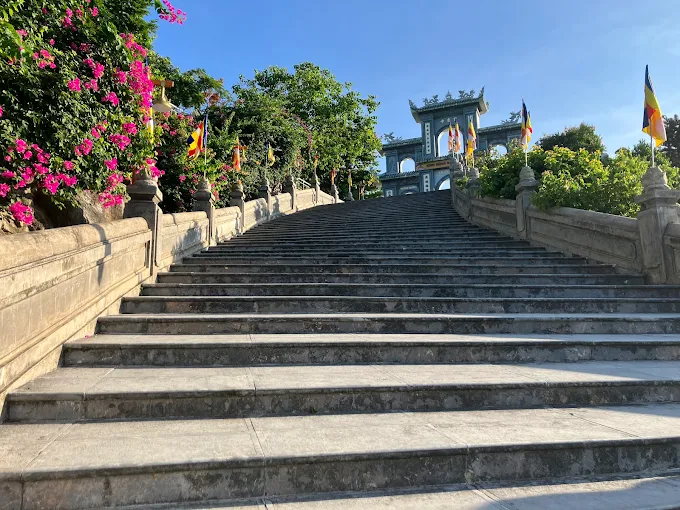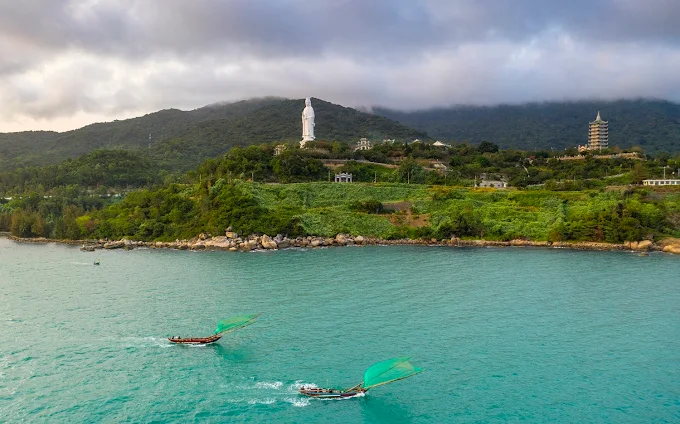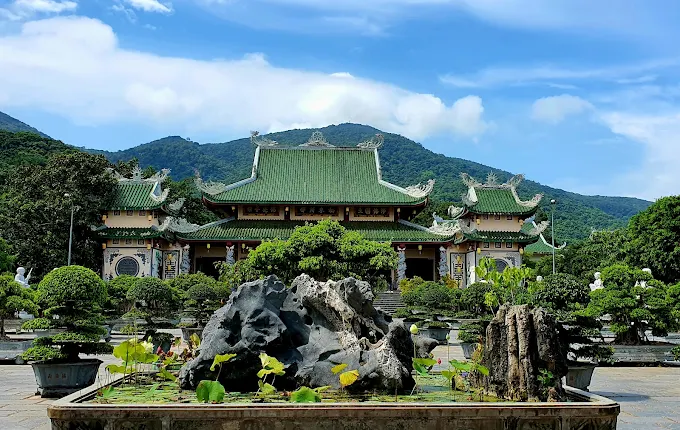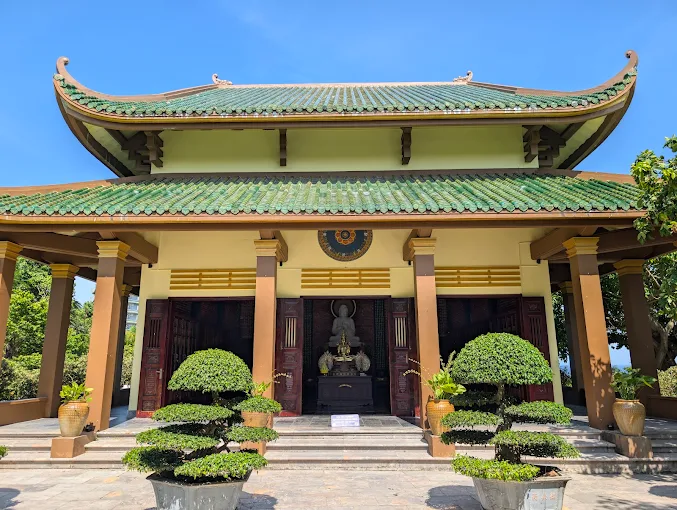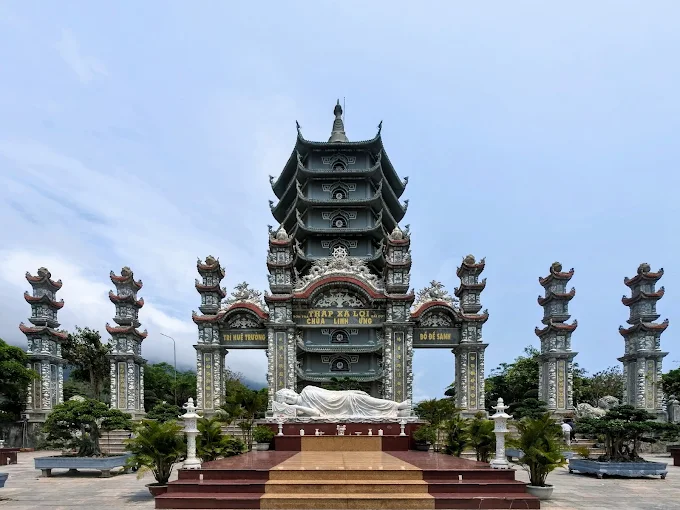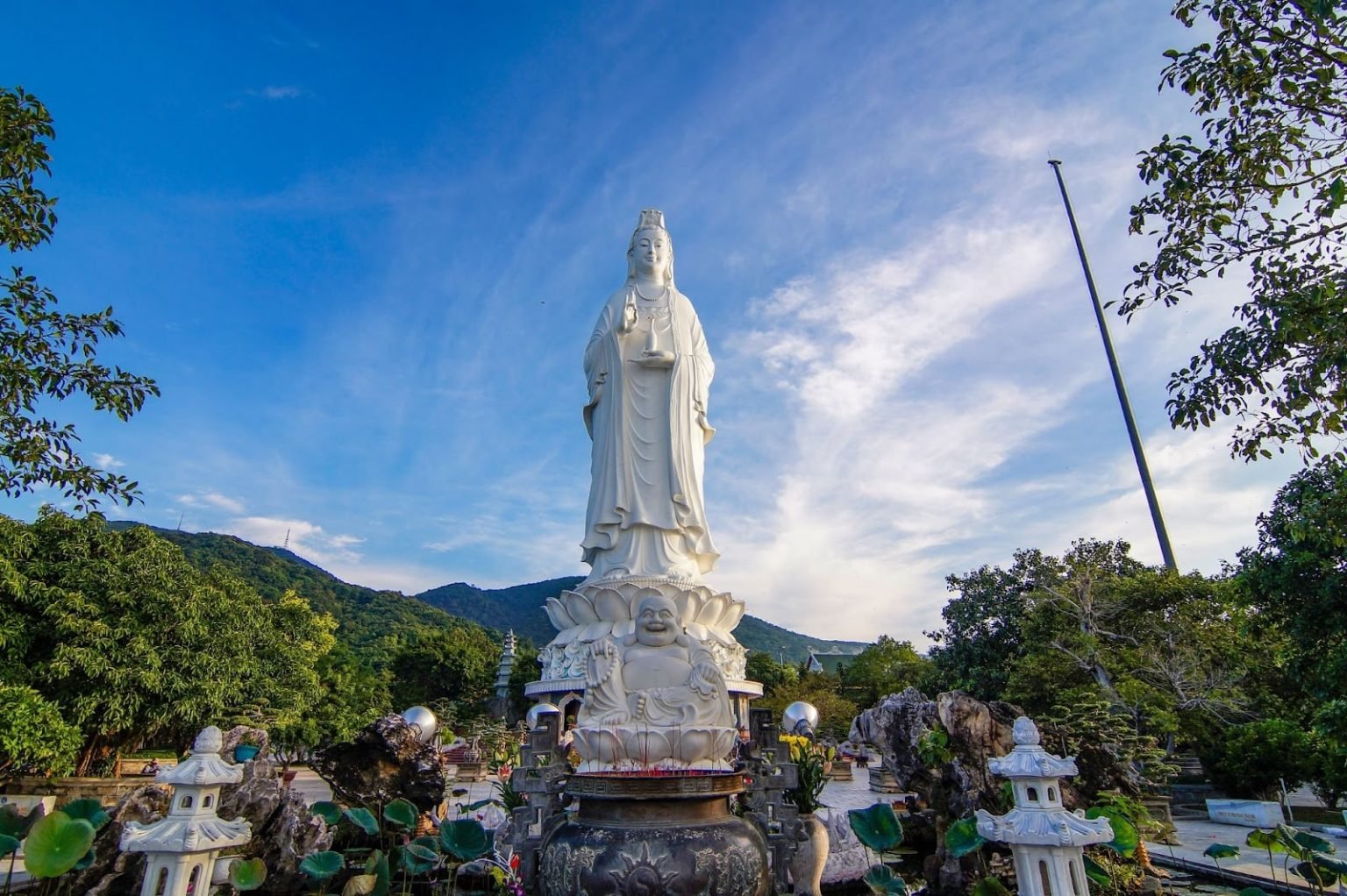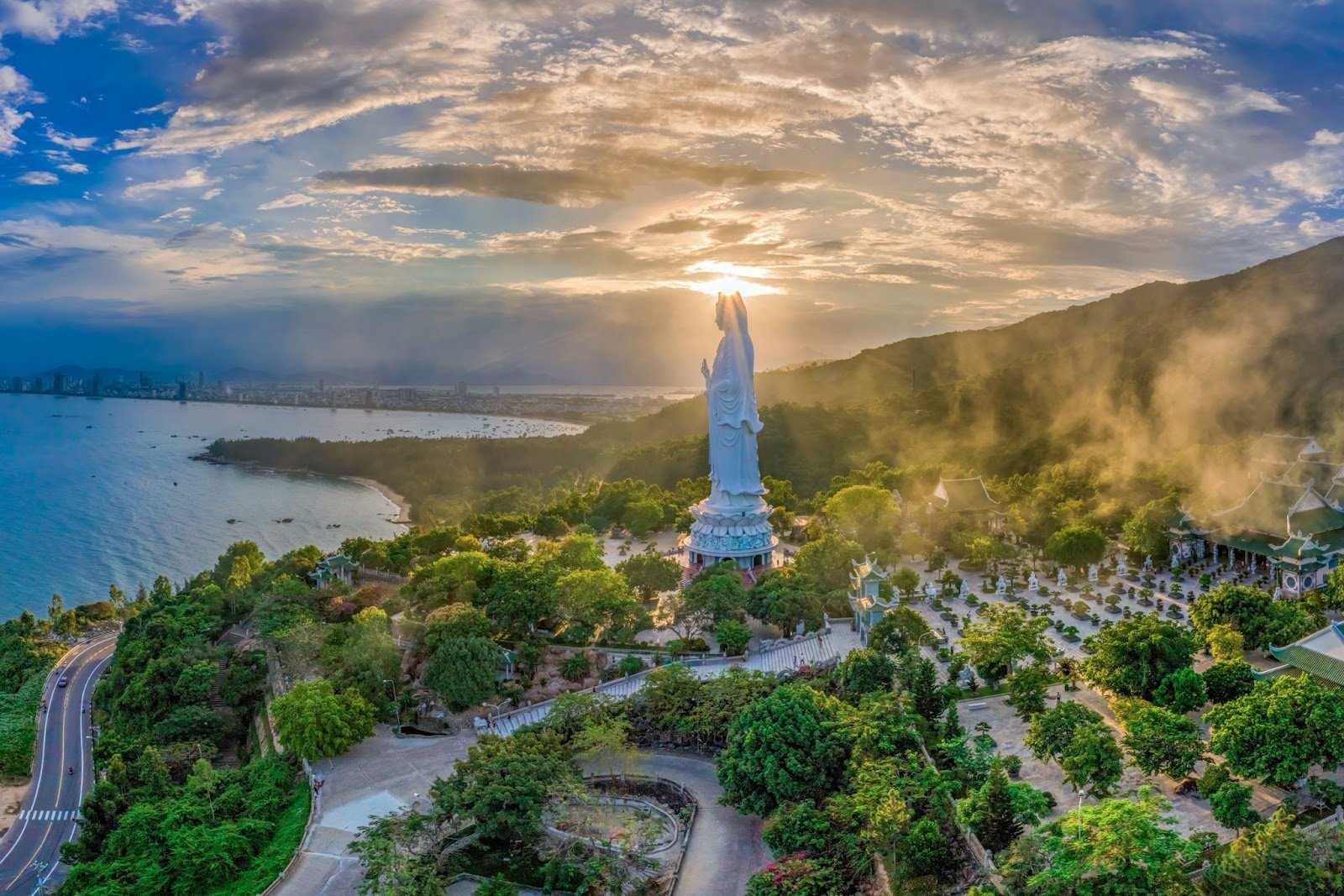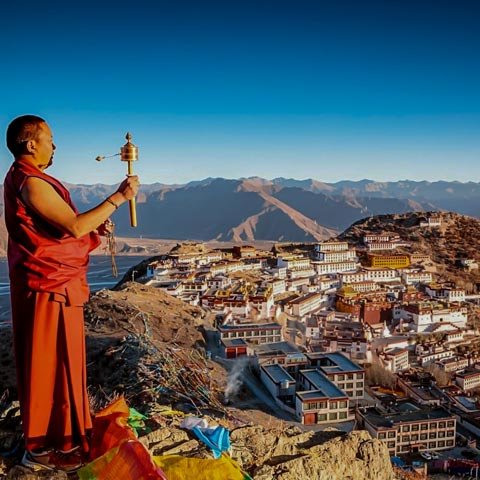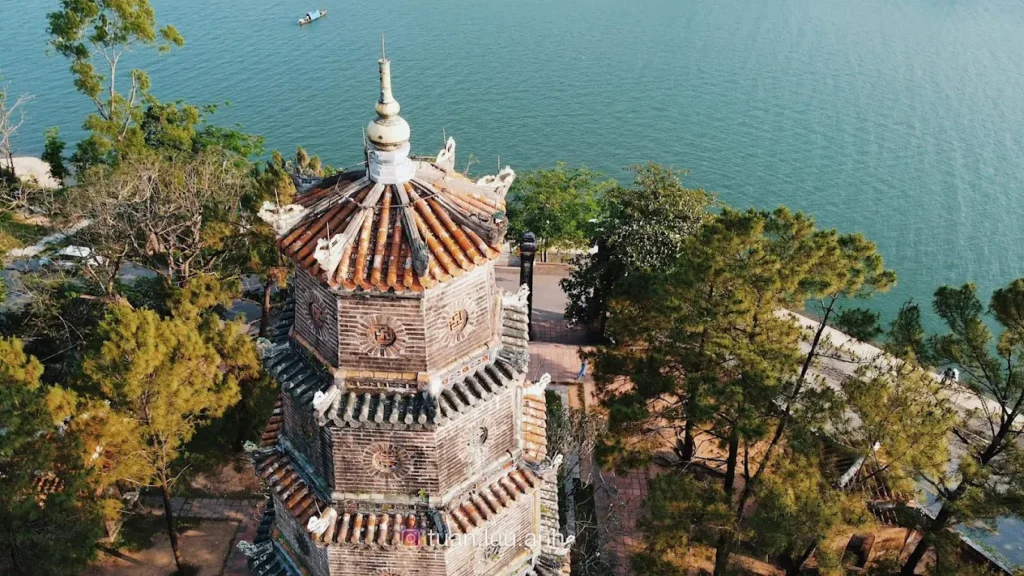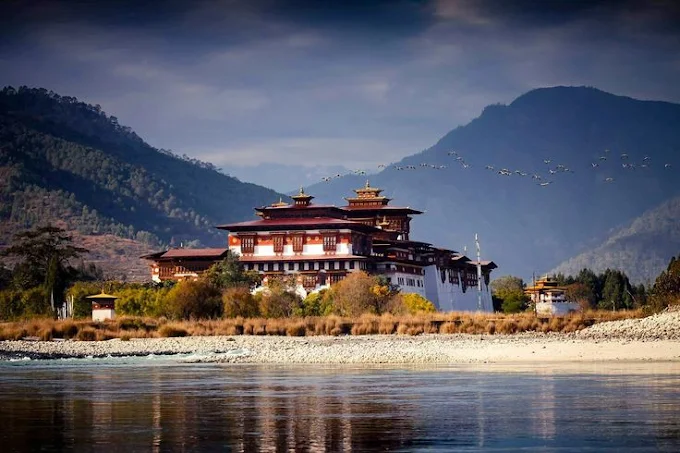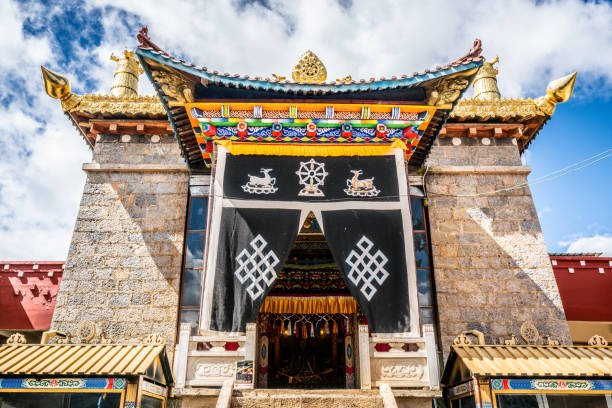Linh Ung Pagoda – Son Tra Peninsula: The Towering Avalokitesvara of Mahayana Grace
As dawn crests over Đà Nẵng’s Son Tra Peninsula, Linh Ung Pagoda awakens, its 67-meter Avalokitesvara statue gazing serenely across the East Sea, a beacon of compassion atop a lotus throne. The air hums with Amitabha chanting, devotees seeking rebirth in Amitabha’s Western Paradise, their voices blending with sea breezes and the scent of sandalwood incense. A lotus bloom sways in the courtyard pond, reflecting the main hall’s dragon-crowned roof, a masterpiece of Vietnamese artistry. This Mahayana sanctuary, perched at 693 meters, invites all to immerse in Vietnam’s vibrant Buddhist heritage.
Overview and Significance
Introduction to Linh Ung Pagoda
Linh Ung Pagoda, nestled on Son Tra Peninsula, stands as Đà Nẵng’s grandest Mahayana Buddhist temple, its colossal 67-meter Avalokitesvara statue—Vietnam’s tallest—embodying the grace of the Pure Land tradition, which centers on devotion to Amitabha Buddha for rebirth in his Western Paradise. Located 10 kilometers from the city center, this sacred haven blends East Asian elegance with Vietnamese architectural designs, offering breathtaking views of Đà Nẵng’s coastline. Its monumental statue, intricate main hall, and vibrant rituals make it a cultural cornerstone, drawing pilgrims, scholars, and tourists into a realm of spiritual serenity.
Historical Journey
Linh Ung Pagoda was founded in 2004 under the guidance of the Vietnam Buddhist Sangha and inaugurated in 2010, fulfilling a vision to create a protective spiritual landmark for Đà Nẵng. Built with community donations, it forms part of a sacred triangle with two other Linh Ung pagodas in the city, symbolizing harmony and safeguarding fishermen. The 67-meter Avalokitesvara statue, completed in 2010, was inspired by a local myth of a Buddha statue drifting to Bai But (Buddha’s Land) during the Nguyen Dynasty, believed to calm the seas.
Since its inception, the pagoda has grown as a pilgrimage site, its history reflecting Đà Nẵng’s blend of spiritual resilience and modern development.
- Patronage: Supported by local Mahayana Buddhists and Vietnam Buddhist Sangha.
- Milestones: Founded in 2004; inaugurated in 2010; Avalokitesvara statue completed in 2010.
Cultural Significance
Linh Ung Pagoda is a vital hub for Đà Nẵng’s Mahayana community, fostering devotion to Avalokitesvara and Amitabha Buddha. Its Pure Land practices, centered on Amitabha chanting, offer solace to devotees and fishermen seeking protection. The pagoda hosts cultural events, like Vesak celebrations and peace-praying ceremonies, drawing thousands to its sacred grounds.
Regionally, it connects with Mahayana communities in Southeast Asia, sharing Pure Land teachings. Globally, it attracts scholars studying Vietnam’s Buddhist architecture and pilgrims drawn to its towering statue and coastal vistas, offering a glimpse into Mahayana’s compassion.
- Mahayana Hub: Preserves Pure Land practices in Đà Nẵng.
- Cultural Role: Hosts Vesak and peace-praying ceremonies.
- Global Appeal: Attracts scholars and pilgrims for its statue and views.
Unique Legacy
The pagoda’s 67-meter Avalokitesvara statue and verdant courtyard define its legacy, embodying Mahayana’s grace. The statue, with 17 floors of inner shrines, and the sacred triangle myth symbolize protection for Đà Nẵng’s seafarers. Vietnamese dragon motifs and lotus carvings reflect local syncretism, while statues like Shakyamuni Buddha anchor spiritual devotion.
This fusion of monumental architecture, spiritual statues, and cultural lore earns Linh Ung Pagoda its title as the “Towering Avalokitesvara of Mahayana Grace,” a global beacon of faith.
- Avalokitesvara Statue: 67-meter icon, Vietnam’s tallest.
- Sacred Statues: Shakyamuni and Avalokitesvara as spiritual anchors.
- Cultural Syncretism: Vietnamese Mahayana influences.
Community and Global Impact
Linh Ung Pagoda thrives as a communal heart for Đà Nẵng’s Buddhist community. On lunar days, devotees gather before the Avalokitesvara statue to chant and offer incense, their prayers rising with sea winds. Charity drives, supporting local fishermen, strengthen community bonds, while Vesak festivals draw thousands with lantern processions and offerings.
Globally, the pagoda hosts Buddhist exchanges, welcoming Southeast Asian monks and scholars. The Vietnamese diaspora supports maintenance, reinforcing cultural ties. Its iconic statue and scenic location cement its global role as a Mahayana sanctuary.
- Local Engagement: Hosts prayers, charity, and festivals.
- Global Reach: Draws pilgrims and scholars from Southeast Asia.
- Diaspora Support: Funded by Vietnamese communities abroad.
Architectural and Spiritual Features
Iconic Design
Linh Ung Pagoda’s architecture blends Mahayana grandeur with Vietnamese elegance, its 67-meter Avalokitesvara statue dominating a 20-hectare complex atop Son Tra Peninsula. The layout centers on the main hall, statue, and lush courtyard, framed by bonsai gardens. Its vibrant palette—white, gold, and red—celebrates Mahayana’s divine splendor, with Vietnamese dragon-shaped roofs and lotus motifs creating a serene contrast to the urban skyline below.
The statue’s lotus throne and the main hall’s sturdy pillars, rooted in local Mahayana traditions, craft a sacred oasis of devotion and awe.
- Avalokitesvara Statue: 67-meter Mahayana icon.
- Vietnamese Aesthetic: Dragon roofs and lotus motifs.
- Coastal Oasis: Contrasts with Đà Nẵng’s skyline.
Key Structures
The main hall, housing revered statues, is the pagoda’s spiritual heart, its ornate altars glowing under soft light. The Avalokitesvara statue, with 17 floors of inner shrines, towers over the courtyard, accessible via ramps. The courtyard, with lotus ponds and bodhi trees, serves as a communal space for festivals. A seven-story tower, adorned with ceramic tiles, offers views of the East Sea, while smaller shrines dot the grounds with intricate carvings.
These structures, harmonizing spiritual and architectural beauty, create a serene Mahayana sanctuary.
- Main Hall: Spiritual heart with revered statues.
- Avalokitesvara Statue: 67-meter tower with inner shrines.
- Courtyard: Communal space with lotus ponds.
Worshipped Statues
The main hall’s Shakyamuni Buddha statue, gilded and seated on a lotus pedestal, radiates enlightenment, its serene gaze anchoring worship. Avalokitesvara, a white porcelain figure with a nectar vase, stands nearby, offering compassion to devotees. Maitreya, crafted in gold leaf with a joyful smile, welcomes visitors, symbolizing future prosperity. Smaller shrines house Mahasthamaprapta, in bronze with a lotus, embodying wisdom, and Ksitigarbha, in jade with a staff, guiding souls from suffering.
These statues, central to Mahayana worship, embody the pagoda’s spiritual essence, their iconography fostering devotion.
- Shakyamuni Buddha: Gilded, symbolizing enlightenment.
- Avalokitesvara: Porcelain, offering compassion.
- Maitreya: Gold leaf, symbolizing prosperity.
Materials and Techniques
The Avalokitesvara statue, crafted with reinforced concrete and white plaster, showcases Vietnamese artisans’ mastery, its 35-meter lotus base symbolizing purity. The main hall’s statues, gilded and carved with lotus motifs, use teak woodwork rooted in local traditions. Stone carvings of Buddhist tales adorn the courtyard, blending Vietnamese craftsmanship with Mahayana symbolism. The seven-story tower features ceramic tiles with dragon patterns, adding durability and elegance.
These materials, grounded in Vietnamese syncretism, create a visually stunning and spiritually resonant sanctuary.
- Concrete Statue: White-plastered Avalokitesvara with lotus base.
- Gilded Statues: Teak woodwork with lotus motifs.
- Ceramic Tiles: Dragon-patterned tower.
Signature Elements
The 67-meter Avalokitesvara statue and main hall are the pagoda’s signature elements, their grandeur symbolizing Pure Land grace. The statue’s inner shrines, housing 21 Buddha statues, glow under festival lights, while the main hall’s dragon roof anchors worship. Vietnamese altars, with red and gold carvings, frame the statues, enhancing their spiritual presence.
These elements, blending architectural and spiritual significance, define Linh Ung Pagoda’s Mahayana identity, captivating all who visit.
- Avalokitesvara Statue: 67-meter icon with inner shrines.
- Main Hall: Dragon-roofed anchor of worship.
- Vietnamese Altars: Vibrant frames for statue devotion.
Lesser-Known Features
The main hall’s ceiling, painted with lotus murals, forms a meditative canopy, often unnoticed in soft light. The courtyard’s stone lanterns, inspired by Vietnamese designs, cast gentle glows at dusk. Smaller shrines house ceramic sutra tablets, offering spiritual insight. A bonsai garden near the courtyard provides a serene retreat, reflecting the pagoda’s tranquil depth.
These subtle details enrich Linh Ung’s spiritual allure, rewarding attentive visitors.
- Lotus Murals: Meditative ceiling in the main hall.
- Stone Lanterns: Vietnamese-style courtyard glow.
- Sutra Tablets: Ceramic inscriptions in shrines.
Preservation and Evolution
The pagoda’s concrete structures withstand coastal humidity, but the statue’s plaster requires periodic maintenance by artisans. Volunteers maintain the courtyard, shrines, and statue altars. The 2010 inauguration marked the addition of the Avalokitesvara statue and seven-story tower, enhancing accessibility and grandeur.
These efforts ensure Linh Ung Pagoda remains a vibrant Mahayana sanctuary, balancing tradition with modernity.
- Maintenance: Periodic statue plaster cleaning.
- Modern Updates: Avalokitesvara statue and tower completion in 2010.
Rituals and Practices
Daily Sacred Rites
Each morning, Linh Ung Pagoda resonates with Amitabha chanting, led by monks before the Shakyamuni Buddha statue, invoking rebirth in the Western Paradise. Devotees offer incense at the incense house, their prayers rising before Avalokitesvara’s compassionate gaze. The courtyard’s bell tolls, grounding worshippers in devotion.
Lay followers present lotus flowers and candles to Bodhisattva statues, bowing in reverence. The courtyard invites sutra recitation, fostering Mahayana’s universal salvation.
- Morning Chanting: Amitabha chanting before statues.
- Incense Offerings: Prayers for rebirth in the Pure Land.
- Sutra Recitation: Quiet courtyard devotion.
Unique Practices
The pagoda’s Pure Land devotion centers on Amitabha chanting, guiding devotees toward rebirth in the Western Paradise. Monks lead daily sessions before the Avalokitesvara statue, cultivating mindfulness. Vegetarian offerings, placed in ornate bowls before Shakyamuni Buddha, emphasize merit-making, reflecting Vietnamese Mahayana traditions.
On full-moon days, monks perform sea-prayer ceremonies, unique to Linh Ung’s coastal setting, blessing fishermen with safety, a practice tied to the Bai But myth.
- Pure Land Chanting: Daily Amitabha sessions.
- Vegetarian Offerings: Merit-making before statues.
- Sea-Prayer Ceremonies: Full-moon rituals for fishermen.
Festival Traditions
Vesak, celebrating Buddha’s birth, enlightenment, and passing, transforms Linh Ung with lantern processions illuminating the courtyard, devotees offering roses before Avalokitesvara. Vu Lan, honoring filial piety, draws crowds pinning roses—red for living parents, white for the deceased—before the statues, as monks chant for ancestral liberation. Tet brings dragon dances and red envelope offerings, blending Mahayana devotion with Vietnamese festivity.
Lunar days attract pilgrims for special Amitabha chanting sessions, with statue veneration, uniting the community in reverence.
- Vesak: Lantern processions and offerings before Avalokitesvara.
- Vu Lan: Rose-pinning and chanting for ancestors.
- Lunar Days: Chanting sessions with statue veneration.
Visitor Engagement
Visitors can light incense or offer lotus flowers before Avalokitesvara at the incense house, guided by monks on Mahayana etiquette. Amitabha chanting sessions, open to all, allow participation in Pure Land practices. During Vesak, tourists may join lantern processions or offer roses before the statues, immersed in spiritual rituals.
The pagoda’s serene atmosphere fosters cultural exchange, with monks sharing insights on statue worship, connecting locals and global visitors.
- Incense Lighting: Guided offerings before Avalokitesvara.
- Amitabha Chanting: Open Pure Land sessions.
- Festival Participation: Lantern processions during Vesak.
Spiritual Community Roles
Linh Ung’s monks, trained in Mahayana Pure Land teachings, lead chanting sessions and mentor devotees. They organize charity drives, supporting local fishermen, strengthening community ties. Lay volunteers maintain statue altars and assist during festivals, fostering a sense of unity.
The abbot delivers sermons on compassion before Avalokitesvara, guiding initiatives. Buddhist devotee groups organize Vesak and Vu Lan events, enriching communal life.
- Monks: Lead rituals, mentor, and organize charity.
- Lay Volunteers: Maintain statue altars and assist festivals.
- Buddhist Devotees: Organize Vesak and Vu Lan celebrations.
Visitor Information
Navigating to Linh Ung Pagoda
Linh Ung Pagoda is located at Bãi Bụt, Son Tra Peninsula, Hoàng Sa, Thọ Quang, Sơn Trà District, Đà Nẵng, its 67-meter Avalokitesvara statue a striking landmark overlooking the East Sea. The nearby Monkey Mountain, a 5-minute drive, offers scenic trails, while Đà Nẵng’s city center, with landmarks like the Dragon Bridge, is a 20-minute taxi ride. The pagoda blends coastal serenity with urban accessibility.
From the city center, visitors can take a taxi or motorbike via Võ Nguyên Giáp and Hoàng Sa roads, enjoying a scenic 10-kilometer coastal drive to Son Tra Peninsula.
- Landmark: 67-meter Avalokitesvara statue on Son Tra Peninsula.
- Nearby Sites: Monkey Mountain (2 km), Dragon Bridge (10 km).
- Central Access: 20-minute taxi from city center.
Address of Linh Ung Pagoda
- Vietnamese: Chùa Linh Ứng, Bãi Bụt, Bán đảo Sơn Trà, Hoàng Sa, Thọ Quang, Quận Sơn Trà, Thành phố Đà Nẵng, Việt Nam.
- English: Linh Ung Pagoda, Bãi Bụt, Son Tra Peninsula, Hoàng Sa, Thọ Quang, Sơn Trà District, Đà Nẵng City, Vietnam.
Visiting Hours and Etiquette
Linh Ung Pagoda is open daily from 6:00 AM to 9:00 PM, with early mornings offering a peaceful setting for chanting before the statues. The main hall and Avalokitesvara statue are accessible daily, with guided tours during festivals like Vesak. Visitors should plan 1–2 hours to explore the complex and enjoy coastal views.
Dress modestly, covering shoulders and knees, and remove shoes before entering the main hall or statue’s inner shrines. Photography is permitted in the courtyard but requires permission inside shrines. Bow three times before statues to show respect, adhering to Mahayana customs.
- Hours: 6:00 AM–9:00 PM daily.
- Access: Main hall and statue open daily; guided during festivals.
- Etiquette: Modest dress, remove shoes, bow before statues.
Accessibility and Safety
The pagoda offers ramps to the courtyard and main hall, but stairs to the Avalokitesvara statue’s upper floors may limit wheelchair access. The courtyard’s flat surfaces suit mobility-impaired guests, and volunteers assist during festivals, guiding visitors to statue altars. Elevators within the statue aid access to some floors.
Son Tra is safe, but coastal winds can be strong—secure loose items. Stay on designated paths to avoid steep slopes, and bring light clothing and water for Đà Nẵng’s humidity.
- Accessibility: Ramps for courtyard; stairs to statue floors.
- Safety: Secure items; stay on paths.
- Assistance: Volunteers available during festivals.
Amenities and Surroundings
Linh Ung Pagoda provides restrooms, drinking water, and shaded benches in the courtyard. A kiosk sells incense and lotus flowers for statue offerings, supporting maintenance. The lotus ponds and bodhi trees create tranquil spots, enhancing the spiritual ambiance.
Hoàng Sa Road offers seafood stalls, while Son Tra Peninsula’s beaches, like My Khe (15 minutes away), provide dining and relaxation. The nearby Monkey Mountain trails offer adventure, enriching the cultural experience.
- Amenities: Restrooms, water, incense kiosk.
- Surroundings: Seafood stalls, My Khe Beach (5 km).
- Sensory Highlights: Sea breezes, incense, coastal views.
Immersive Visitor Tips
Arrive at 6:00 AM to join Amitabha chanting before the Shakyamuni Buddha statue, fostering mindfulness. During Vesak, offer a lotus flower before Avalokitesvara and join a lantern procession, immersing in spiritual unity. Photograph the statue at sunrise, its white form glowing against the sea, but avoid flash near shrines.
Explore Monkey Mountain trails post-visit, or relax at My Khe Beach for local cuisine. Visit on lunar days for statue veneration and coastal serenity, deepening your connection.
- Morning Chanting: Join Amitabha sessions early.
- Sunrise Photography: Capture the statue’s glow.
- Festival Immersion: Offer lotuses during Vesak.
